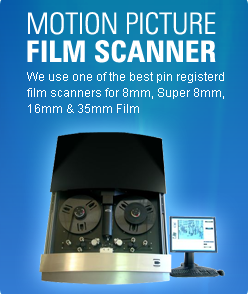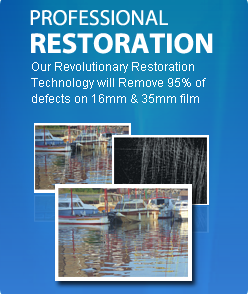
Regular 8mm movie film was never sold commercially with a sound strip but some people did attach a sound strip themselves. Super 8 film has the option but you had to buy the film with the sound strip on it and you had to have a sound camera and microphone. 16mm had both magnetic and optical. On the order form you can let us know if you think your film has sound on it. It does take extra effort to capture the sound and incorporate it into the requested formats. So, we do charge a little more for sound film.
We can not capture any digital audio like Dolby Digital or Sony Dynamic Digital Sound.


The above picture is just an example. 16mm sound film came in many different varieties. 16mm film with optical sound will have sprocket holes on 1 side. The other side will carry the audio track.
There is no sound on Regular 8 film. At least it wasn't produced that way. There were some people that put a magnetic sound strip on 8mm film themselves. There was also some test 8mm film with sound that Kodak used to prepare for Super 8 film.
Even though Super 8 film was sold in two versions, sound and silent, most Super 8 film is silent. Only about 5% of all Super 8 movie film has sound on it.
Super 8 sound could be recorded with a microphone during filming or could also be recorded using a projector when the film played. The quality of the sound varied widely.
Green Bay Fun Facts: Routes 41 and 141; and Wisconsin State Highways 29, 32, 54, 57, and 172. The area where the Fox River empties into the Green Bay was a natural stopping place as far back as the 17th century for many types of travelers, including French voyagers, woodland Indian tribes, fur trappers, and Jesuit missionaries. This stopping place became Wisconsin's first settlement in 1634, only 14 years after the Pilgrims landed at Plymouth Rock. The French first settled the area, before being driven out by the British in 1763, who retained it as a stronghold until after the war of 1812.
Wisconsin Fun Facts: It was admitted to the union as the 30th state in 1848.In the years leading up to the Civil War,Wisconsin was an important stop on the Underground Railroad, with manyslaves passing through the state on their way to freedom in Canada. Today, Wisconsin leads the nation in dairy production and is known for the quality of its cheddar cheese–residents even sometimesrefer to themselves as “cheeseheads.” Famous Wisconsinites include architect Frank Lloyd Wright, magician Harry Houdini andU.S. Army General Douglas MacArthur. Wisconsin became aU.S.





